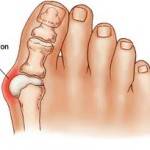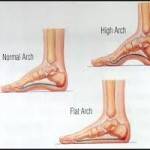Common Foot Problems
Achilles Tendonitis
Achilles tendonitis is a condition wherein the Achilles tendon, at or near its insertion to the back of the heel, becomes inflamed and causes pain. Get help from a doctor and have treatment for this foot pain.
Arthritis
Arthritis is the leading cause of disability in the United States. It can occur at any age, and literally means “pain within a joint.” As a result, arthritis is a term used broadly to refer to a number of different conditions. Seek medical advice from a professional at a health clinic.
Back Pain
Back pain associated with the feet is often a result of asymmetry or a lack of alignment from the ground up. When our bodies are out of alignment from beginning at the ground, it can have a serious impact on our entire skeletal system which results in foot pain as well.

Bunions
A bunion is a deviation and inflammation of the joint where the big toe connects to the 1st metatarsal, also known as the 1st MTP. The capsule of the joint is displaced, thickened, and enlarged, and the cartilage of the joint is damaged. There are three degrees of bunions: mild, moderate, and severe. While bunions themselves are not hereditary, there is a hereditary component to the tendency to overpronate, which is one of the main causes of bunions.

Calluses
Calluses are thick, hardened layers of skin that develop when your skin tries to protect itself against friction and pressure. Calluses vary in size and shape, though they are often larger than corns.

Diabetes
Type 1 diabetes, once known as juvenile diabetes or insulin-dependent diabetes, is a chronic condition in which the pancreas produces little or no insulin, a hormone needed to allow sugar (glucose) to enter cells to produce energy. Type 2 diabetes, which is far more common, occurs when the body becomes resistant to the effects of insulin, or doesn’t make enough insulin.

Fallen Arches (PTTD)
Posterior tibial tendon dysfunction is one of the most common problems of the foot and ankle. It occurs when the posterior tibial tendon becomes inflamed or torn. As a result, the tendon may not be able to provide stability and support for the arch of the foot, resulting in a flatfoot.

Hammer Toes
A hammertoe is a deformity of the second, third or fourth toes. In this condition, the toe is bent at the middle joint, so that it resembles a hammer. Initially, hammertoes are flexible and can be corrected with simple measures but, if left untreated, they can become fixed and require surgery as a last resort treatment.

Heel Spurs
The heel bone is the largest bone in the foot and absorbs the most shock and pressure. A heel spur develops as an abnormal growth of the heel bone. Most commonly, calcium deposits form when the plantar fascia pulls away from the heel area, causing a bony protrusion, or heel spur to develop.

IT Band Syndrome
ITBS is one of the leading causes of lateral (outside) knee pain in runners. The iliotibial (IT) band runs from the hip to the outside of the end of the lower leg just below the knee. Its function is to resist internal rotation of the lower leg as well as maintain the integrity of the leg at the knee joint. IT band “friction syndrome” is a condition where the IT band is stretched and torqued and the end rubs across the bone of the upper leg.

Knee Pain
Patellofemoral pain syndrome, also known as Runners Knee, is a degenerative cartilage health condition wherein the cartilage on the back of the patella (knee cap) is irritated and painful because it rubs against the bone of the upper leg.

Metatarsalgia
Generalized foot pain underneath the metatarsals (ball of the foot). Metatarsalgia common symptoms/complaints include a sharp, aching, or burning pain in the ball of your foot ” the part of the sole just behind your toes, pain in the area around your second, third or fourth toes ” or, only near your big toe, pain that gets worse when you stand, walk or run and improves when you rest… So go ahead and talk to your doctor for treatment.

Morton’s Neuroma
Morton’s neuroma occurs as the nerve passes under the ligament connecting the toe bones (metatarsals) in the forefoot. Morton’s neuroma most frequently develops between the third and fourth toes, usually in response to irritation, trauma, or excessive pressure. The incidence of Morton’s neuroma is 8 to 10 times greater in women than in men.

Neuropathy
Neuropathy is a collection of disorders that occurs when nerves of the peripheral nervous system (the part of the nervous system outside of the brain and spinal cord) are damaged. The condition is generally referred to as peripheral neuropathy. Neuropathy usually causes pain and numbness in the hands and feet. It can result from traumatic injuries, infections, metabolic disorders, and exposure to toxins. Get help from your doctor and seek medical advice.

Plantar Fasciitis
Plantar fasciitis is a condition where the plantar fascia is pulling on the heel bone and therefore causing inflammation and pain. The plantar fascia is the connective tissue that acts as a stabilizer and maintains the integrity of the arch of the foot. It originates at the bottom of the heel bone, is attached to the ball of the foot, and continues forward to insert at the toes.

Pronation
Pronation is the tri-planar motion that allows us to transfer weight from our heels to the balls of our feet during gait. The most important thing to understand about pronation is that it is necessary. Normal pronation is the ideal situation for anyone. If an individual overpronates or under pronates, they may experience problems. Seek medical help from a health professional.

Shin Splints
The term “shin splints” refers to pain and tenderness along or just behind the inner edge of the tibia, the large bone in the lower leg. Shin splints–or medial tibial stress syndrome -usually develop after physical activity, such as vigorous exercise or sports. Repetitive activity leads to inflammation of the muscles, tendons, and periosteum (thin layer of tissue covering a bone) of the tibia, causing pain. The bone tissue itself is also involved.











